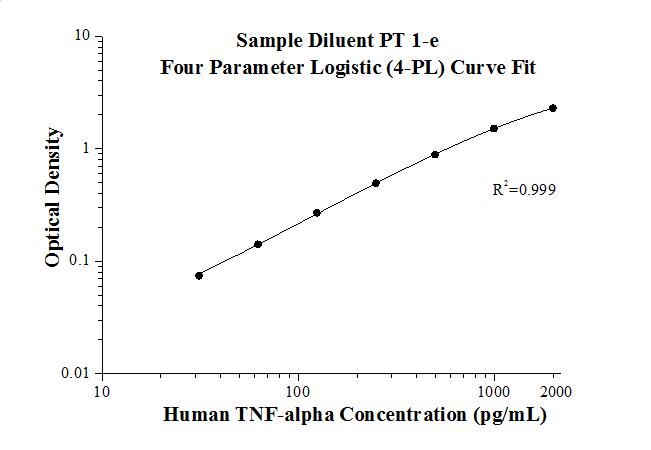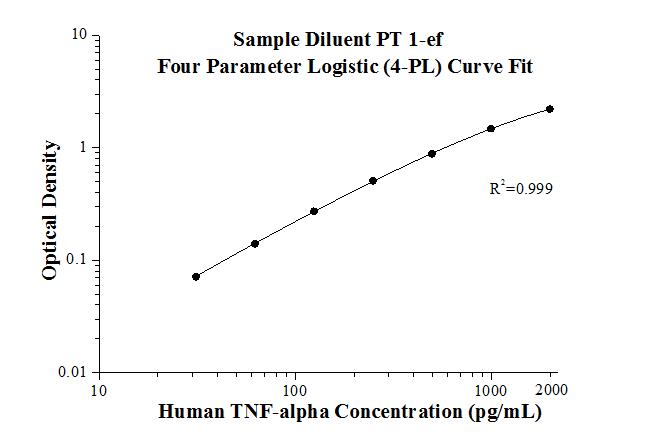Human TNF-alpha ELISA Kit
Validation Data Gallery
Product Information
KE00068 is a solid phase sandwich Enzyme Linked-Immuno-Sorbent Assay (Sandwich ELISA). The TNF-α ELISA kit is to be used to detect and quantify protein levels of endogenous TNF-α. The assay recognizes human TNF-α. An antibody specific for TNF-α has been pre-coated onto the microwells. The TNF-α protein in samples is captured by the coated antibody after incubation. Following extensive washing, another antibody of biotinylated specific for TNF-α is added to detect the captured TNF-α protein. For signal development, Streptavidin-HRP is added, followed by Tetramethyl-benzidine (TMB) reagent. Solution containing sulfuric acid is used to stop color development and the color intensity which is proportional to the quantity of bound protein is measurable at 450 nm with the correction wavelength set at 630 nm.
| Product name | Human TNF-alpha ELISA Kit |
| Tests | 1 X 96 well plate |
| Sample type | Serum, Plasma, Cell culture supernatants |
| Assay type | Sandwich |
| Sensitivity | 1.0 pg/mL |
| Range | 31.25-2000 pg/mL |
| Reactivity | Human |
| Tested applications | Sandwich ELISA |
| Gene ID (NCBI) | 7124 |
Recovery
| Sample Type | Average | Range |
|---|---|---|
| Human plasma | 77% | 70%-86% |
| Cell culture supernatants | 100% | 81%-126% |
IntraAssay
| Sample | n | mean ( pg/mL) | SD | CV% |
|---|---|---|---|---|
| 1 | 20 | 365.8 | 11.0 | 3.0 |
| 2 | 20 | 747.8 | 42.2 | 5.6 |
| 3 | 20 | 1,508.1 | 96.9 | 6.4 |
InterAssay
| Sample | n | mean ( pg/mL) | SD | CV% |
|---|---|---|---|---|
| 1 | 24 | 392.2 | 21.0 | 5.4 |
| 2 | 24 | 774.4 | 33.5 | 4.3 |
| 3 | 24 | 1,572.5 | 61.9 | 3.9 |
Background Information
TNF, as also known as TNF-alpha, or cachectin, is a multifunctional proinflammatory cytokine that belongs to the tumor necrosis factor (TNF) superfamily. It is expressed as a 26 kDa membrane bound protein and is then cleaved by TNF-alpha converting enzyme (TACE) to release the soluble 17 kDa monomer, which forms homotrimers in circulation. It is produced chiefly by activated macrophages, although it can be produced by many other cell types such as CD4+ lymphocytes, NK cells, neutrophils, mast cells, eosinophils, and neurons. It can bind to, and thus functions through its receptors TNFRSF1A/TNFR1 and TNFRSF1B/TNFBR. This cytokine is involved in the regulation of a wide spectrum of biological processes including cell proliferation, differentiation, apoptosis, lipid metabolism, and coagulation. Dysregulation of TNF production has been implicated in a variety of human diseases including Alzheimer's disease, cancer, major depression and inflammatory bowel disease (IBD).
Properties
| Storage Instructions | All the reagents are stored at 2-8℃ for 6 months or -20℃ for 12 months. Refer to the protocol for further storage instructions. |
| Synonyms | Cachectin, DIF, TNF, TNFA, TNF-a, TNFSF2 |
Publications
| Species | Sample Type | Title |
|---|---|---|
Oxid Med Cell Longev Tilianin Ameliorates Cognitive Dysfunction and Neuronal Damage in Rats with Vascular Dementia via p-CaMKII/ERK/CREB and ox-CaMKII-Dependent MAPK/NF-κB Pathways. | ||
BMC Med HBeAg mediates inflammatory functions of macrophages by TLR2 contributing to hepatic fibrosis. | ||
Oncogene Hypoxic glioma-derived exosomes deliver microRNA-1246 to induce M2 macrophage polarization by targeting TERF2IP via the STAT3 and NF-κB pathways. | ||
Int J Mol Sci Isolation and Assessment of a Highly-Active Anti-Inflammatory Exopolysaccharide from Mycelial Fermentation of a Medicinal Fungus Cs-HK1. | ||
Cell Prolif Long non-coding RNA 01126 promotes periodontitis pathogenesis of human periodontal ligament cells via miR-518a-5p/HIF-1α/MAPK pathway. | ||
Front Cell Dev Biol miR-7-5p Affects Brain Edema After Intracerebral Hemorrhage and Its Possible Mechanism. |

